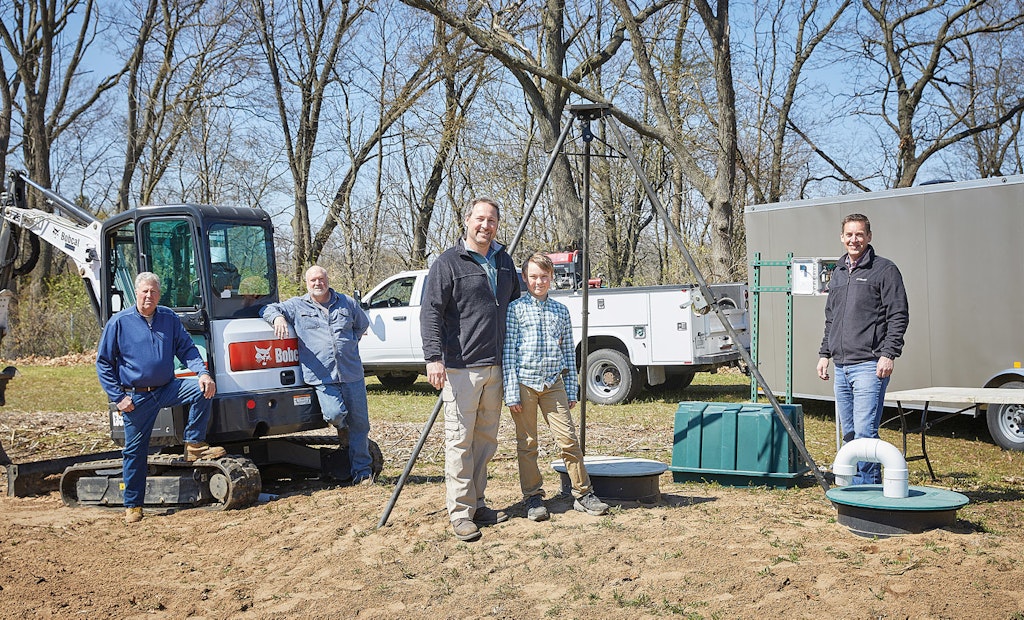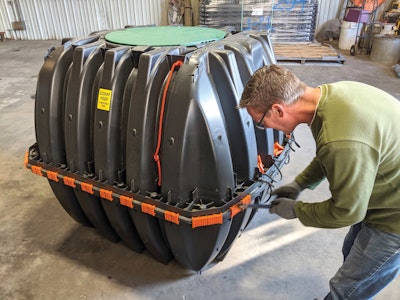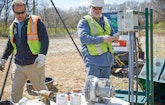
The crew includes, from left, Wayne Street, Ken Thomas, Ray Tebo, Luke Tebo and Keith Anderson. They are shown at the company research and development site with a Bobcat excavator and equipment assembled by the staff. (Photos by Miles Boone)
Ray Tebo grew up on a farm near St. Anne, Illinois, where he now runs his wastewater business, New Excavating Technology. He likes digging, and his happiest days are the days when he can go out on a farm and run equipment.
He can’t dig as much as he wants to, and he shouldn’t, he says. “For onsite installers, they can’t be the guy in the excavator. They have to be the owner. If I’m an operator, the company stands still.”
It’s the reality of running his diverse, multispecialty business that is becoming more specialized as it grows.
EMBRACING ONSITE
“We dig all year round,” Tebo says.
Not all of that is for his wastewater business. He also oversees some family farmland and excavation work, and he keeps his crew busy by shifting them from one type of work to another.
As his onsite business evolved, Tebo found it more interesting to specialize, a move that also opened more opportunities. Like many businesses, he started with the basics. Excavating and septic work followed naturally from his farm background, where neighbors were always helping other neighbors dig and where a few people had installing licenses. At first he built lagoons and worked on sewers.
“As the developments moved farther out, we weren’t hooking up city sewers anymore. All the houses we would do were asking for a septic system. So I decided to get my license,” he says.
Yet he didn’t do many septics. He worked on aerobic treatment systems. His shifts in work focus often came from a request. A company representative would ask for help, Tebo accepted, and that built his experience and led him to offer a different service.
He installed his first membrane bioreactor in 2013.
“What led me to the MBRs was my search for a better type of aerobic system. I wanted to try MBRs, I called the rep, and he invited me to put in MBRs.”
Sometimes the company still installs aerobic systems, but that’s primarily for existing customers.
Work splits into about 80% MBRs and 20% everything else. MBR work is commercial work, and one of those jobs can be bigger than all the houses he installs in a given year, Tebo says.
“We’ve done a lot of special projects really far away,” he says.
TRAVEL TIME
One of those projects was at a grain depot along the Mississippi River, about 250 miles from St. Anne. The site was a flood plain, and the building for the depot’s workers sat on stilts 8 feet above the ground. Tebo proposed the membrane bioreactor because its effluent is clean enough for discharge into the river.
He and his crew used a precast concrete vault, 10 feet by 25 feet and 8 feet tall. Inside they put 2-inch hard insulation panels and sand to insulate the MBR and other components from the weather.
A disadvantage of working on such specialized, one-time projects, Tebo says, is there is no one to call for advice. He and his technicians have to solve problems largely on their own.
Another disadvantage in his part of the market is a lack of competition. There isn’t a selection of companies from which he can pick the right components, he says.
Because his jobs are so customized, information about system performance isn’t widely available. Tebo once bought another tool truck so he and a technician could drive every month to 30 job sites around the state and download data from panels. Then Tebo studied the data to learn how those systems were performing. “I did that on my dime, but that’s how you have to do it sometimes in the specialized fields,” he says.
From all of this learning, he has settled on a direction: membranes.
“I studied membrane systems all around the world,” Tebo says. “I spent a lot of time traveling and looking at them. And it really seemed to me that in my life, membranes are the thing of the future.”
This means more than MBRs, he adds. There is room for membranes in many applications from water to chemical plants and glass factories — any industrial operation that needs to have water cleaned for cooling or machinery. There is room for this beyond central Illinois.
“You know, we have a lot of good, open land here. But a lot of places in the world, especially some Asian countries, they don’t have the land, and so membranes are becoming really, really important,” he says.
The same thinking applies around large U.S. cities where municipal sewer systems cannot be expanded fast enough to keep up with the sprawl of development, he says.
Tebo sees his own company as moving into anything that involves membrane technology. He said he’s already been asked to perform jobs hundreds of miles from his home base.
EQUIPMENT CORNER
For the work he does, Tebo keeps an inventory of equipment that allows him to do jobs of almost any size. New Excavating Technology operates with:
- Three mini-excavators: a Bobcat E85, Bobcat E35 and Bobcat 418
- Bobcat T650 compact track loader
- Komatsu D21P dozer
- Kobelco excavator
- John Deere 4066R tractor
- John Deer UTV Gator
Other equipment is rented as needed.
To move equipment, they use all-aluminum trailers from Lightning (a division of Forest River). Lighter-duty jobs are handled with Aluma trailers.
Machines lighter than 10,000 pounds in most cases are moved in enclosed trailers. Even for service work, technicians are now pulling enclosed trailers to job sites. Aside from keeping equipment out of the weather, enclosed trailers have other advantages, Tebo says.
“The wind doesn’t blow away your parts, or your instructions, or your electrical diagram,” he says. Membranes can’t be wet until they’re about to receive effluent, and working inside makes it easier for technicians to deburr and glue pipes and assemble other fittings.
The people who make the installation division run are Wayne Street, Keith Anderson and Ken Thomas.
That is a small group for all the work the company does, and it’s small because other work is subcontracted. Jobs are so specialized and Illinois workmen’s compensation is so expensive that it makes economic sense to subcontract complex subspecialties such as electrical wiring or commercial plumbing, Tebo says.
WORKING SMART
For planning his specialty work, Tebo has set up a special space. There is a shop where major components can be built and dry-fitted so technicians aren’t struggling in the field. The grain depot job is an example; components were fitted and test-assembled in the shop. As a result, installation took only two days from start to startup.
Tebo had high-speed internet extended to his shop out in the country so technicians would have easy access to information.
“We have an 80-inch screen where we bring up jobs. The guys all come in and we sit there and go through the jobs. We looked at one this morning: what that job site is going to look like, where people are going to be, where the subcontractors are going to be and how we’re going to mount the equipment. And we do that in comfort,” he says. “The guys have a cooking area in there. They have washing machines and a shower, so if somebody comes home and they have sewage water on them, they can wash their clothes. There is also a restroom and bedroom in case workers, clients or product reps need to spend the night. We’re in the process now of setting up our own lab because if we make an adjustment, it needs to be tested and I don’t want my guys to drive an hour to drop something off at a lab.”
The building also contains tanks to clean membranes that have been removed from reactors, and there are other tanks to test the membranes before they’re installed in another system. There is a test MBR for fitting components and testing for vibration, vacuum, electricity consumption and aeration.
There is also a machine shop because each of his jobs seems to require customized parts, he says. One of his employees is skilled at basic machining and ultrasonic welding. Complicated work goes to a local CNC company.
All the planning and fitting obviously needs a long lead time, but Tebo’s jobs have that because they’re commercial projects requiring months for design and permitting. He says it’s typical to plan jobs one to three years ahead.
SUBCONTRACTING SUITS HIM
Looking at the future takes a different form when it comes to the people who will do the work.
“As I get older especially, I really like to see young people trying hard and getting into things, and I try to help them,” says Tebo, who is 41. When younger installers pick up material from one of the product lines he represents, one point he makes is the need to plan carefully.
“I tell them, ‘You really only have about 120 permit digging days a year, and you have to price your business upon that. So one-third of the days in the year — not counting service work — have to make all the money for the company for the year,’” he says. “You should see some 23-year-old coming to get materials and looking at you like you’re crazy for saying this, but then you see it spinning in his head. He starts to understand how valuable the time is.”
Limited time is another reason why Tebo began using subcontractors. Get everyone lined up, he says, and it’s easier to do a lot of work in a small amount of time because if one part of a job is slow, it does not prevent other people from working on other projects.
Subcontractors also fill the gap that everyone finds when trying to find skilled workers, Tebo says. “Even though you’re paying a lot more, the subcontractors show up,” he says.
It reduces profit, but the job is done perfectly, he says. What he’s doing is trading short-term gain for longer-term benefits. First, when a job is done properly the first time, there won’t be a callback to fix problems. Second, it builds on his company’s reputation.
For a couple of years, Tebo says, he’s sent a tank-setting crew out ahead of other workers. That means the digging crew can dig on a beautiful 78-degree F day while the people doing mechanicals are handling another phase of a different job, he says.
BROADENING THE BUSINESS
Tebo’s home base is in a fast-growing area about 70 miles south of Chicago. This means more work for Tebo’s company, but it also means less time to rest. “We used to enjoy five or six weeks of downtime a year,” Tebo says. “We would get in the shop and turn wrenches. We struggle now to get that time.”
It means relying more on dealerships to take care of machinery, he says. It also means he and his employees are less able to get away. During any given winter, Tebo used to attend four or five trade shows and take some of his guys along so they could expand their knowledge and have some recreation. It’s harder to do that now.
His future is about to be busier because after about two years of work, he is beginning to manufacture a modular MBR system that will scale to whatever flow is required. It’s for his new membrane-installation company, Recycled Water Technologies. New Excavating Technology will continue regular installations, and the new company (which meets NSF/ANSI Standard 350) will handle specialty membrane installations.
The company is at the point of needing more people, although that also means adding trucks, tools, benefits and other associated costs. So again, Tebo is thinking about subcontractors and the future of the whole industry.
“It’s very, very hard to get young people interested in this work,” he says. “I think the industry is still looked down upon for being a rough industry where people get dirty.”
TIME FOR EMPLOYEE OWNERS?
Greater use of technology may attract younger people, he says, because they may prefer watching and adjusting 200 systems on a tablet. As he looks at the small-business landscape, he also sees more younger people who want to work for themselves instead of being an employee of someone else. Perhaps that is the incentive to keep people in wastewater careers, he says.
Or perhaps it is time for employee-owned companies. Tebo has heard about that idea, arrangements where in a small company each employee may own 10% while the boss owns 50%. He’s been thinking about that for his own company but hasn’t reached the point of creating it.
For the moment, Tebo is busy creating a better and more interesting future for himself and his employees.
Utilizing advanced controls for excavation
Successful completion of a job requires good planning, and the day is here when planning includes punching a program into a computer that controls the digging. This is not new for Ray Tebo, owner of New Excavating Technology in St. Anne, Illinois. It is an outgrowth of computer controls that have been common for 20 years in the agriculture industry he grew up with.
“We’re working on a lot of really specialized grade control and mapping,” Tebo says. He means setting parameters in a computer on the excavator before technicians are on the job site. “When we get there, the operator can’t push down and dig any deeper than he’s supposed to,” he says.
For example, a sensor on a bucket is linked to a GPS system and steering so the computer knows where it is at any given moment and how deep a piece of equipment should be.
Mapping is necessary before the components are covered.
“It’s so critical for the future, for the technicians or for somebody going back to replace something and repair something,” Tebo says. “You have a lot of accidents: garbage trucks run over something or concrete trucks run over something. We see this on a yearly basis.
“Supposedly now we have accuracy to 1 inch in a mile,” he says.
While precision and speed are benefits of this technology, it also helps control worker compensation costs.
“If I have to dig a hole 8 feet deep, 40 feet long, 12 feet wide, and the operator can dig at the correct depth without anybody even thinking about going down in the hole, it’s just a huge advantage to me for safety, insurance, everything.”
Machine grade controls and mapping are only three to five years old for the onsite industry, he says, and it’s still very expensive.










